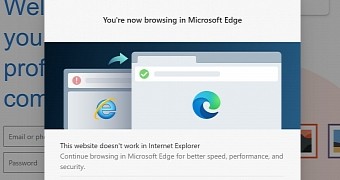Microsoft has already completed the transition from EdgeHTML to the Chromium engine, so the new Microsoft Edge is now running on the same engine as Google Chrome.
What this means is that Microsoft Edge is now available cross-platform too, so in addition to Windows 10, it’s also available on Windows 7, Windows 8, Windows 8.1, macOS, and Linux.
All the effort the company has put in getting Microsoft Edge right convinced the company it’s time for everyone on Windows to at least give a try to the new browser, though in some cases, the software giant’s tactics have been rather aggressive.
The most recent change concerning Microsoft Edge actually impacts Internet Explorer, though it goes without saying you should no longer use this old browser on a Windows device. Despite still getting security patches, Internet Explorer should no longer be used as a daily browser, and Microsoft itself urged everybody to make the switch to a modern app.
“You see, Internet Explorer is a compatibility solution. We’re not supporting new web standards for it and, while many sites work fine, developers by and large just aren’t testing for Internet Explorer these days. They’re testing on modern browsers,” Chris Jackson, Microsoft engineer, said.
“So, if we continued our previous approach, you would end up in a scenario where, by optimizing for the things you have, you end up not being able to use new apps as they come out. As new apps are coming out with greater frequency, what we want to help you do is avoid having to miss out on a progressively larger portion of the web!”
And yet, some people are still using Internet Explorer on their Windows 10 devices, and Microsoft knows this is happening. And most recently, the company has implemented another change that pushes all these users to the new Microsoft Edge.
As discovered recently by TechDows, some of the websites that load in Internet Explorer are now considered to be incompatible, and users are automatically moved to Microsoft Edge. In other words, these incompatible websites, as it’s the case of LinkedIn, are then automatically reloaded in Microsoft Edge, no matter if users agree with it or not.
This is the new default behavior in Internet Explorer, and users are provided with the following message when the website is loaded in Microsoft Edge:
“The website doesn’t work with Internet Explorer. Microsoft recommends continuing in Microsoft Edge to experience better speed, performance and security.”
For the time being, it’s actually possible for users to block the redirect to Microsoft Edge, though it goes without saying that sooner or later, the transition to a modern browser should still happen. Internet Explorer is no longer capable of dealing with the modern web experience, so Microsoft actually sending users to Microsoft Edge is eventually a good thing.
When it comes to blocking this new switch to Edge, it all comes down to rather few clicks that you need to do in Internet Explorer’s settings. So first of all, in Internet Explorer click the gear icon and launch the Internet Options and click the Advanced button. Next, look for the Browsing section and make sure the option called “Enable third-party browser extensions” is not enabled.
Save the changes, close all windows and then try to load the incompatible browsers in Internet Explorer.
Microsoft itself will most likely continue to insist on users to try out the new Edge browser, especially on Windows 10 where this app is now offered as the new default option.

 14 DAY TRIAL //
14 DAY TRIAL //